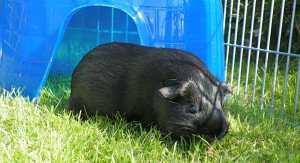
Guinea pigs must have a run. c. Carrie and Simon Evans www.petbehave.co.uk
If you keep them outdoors you will need a hutch and a separate run (essential). Guinea pigs enjoy the fresh air and sunlight that can only be found in a run but a run cannot be used in cold winter weather. Buy the biggest hutch and run that you can afford. Tiny cages give guinea pigs stressy habits (Normando & Gelli 2011). So-called starter packs sold in pet shops are always too small. The minimum size for two guinea pigs should be 4ft by 2ft (ensure this is the internal not the external measurement) – but larger is better. Guinea Pig Welfare recommend UKRabbitHutches. Wheek and Squeak recommend Ryedale Pet Homes. Both of these manufacturers can do bespoke features such as covered or sided ramps, which are highly advisable to prevent injuries.
There should always be a sleeping compartment for the guinea pigs to retreat to. Never buy a hutch/run with a wire floor – these injure the guinea pig’s delicate feet (Reinhardt 2002). Be careful about hutches with ramps. Guinea pigs may injure themselves on a wire ramp or fall off a solid one if they are in a panic. If you are good at DIY you could make the ramps safe by adding sides to them so the guinea pigs cannot fall off. All outside runs should have a wire ceiling to keep out predators like cats and birds. For ideas for runs look here.
Make sure the hutch is weather proof. Damp is worse for guinea pigs’ health than cold (Kaiser et al., 2010). Take a careful look at the hutch and reject it if it is made of thin plywood or not properly put together. You must supply places to retreat to in a run, like tunnels (builders merchants might supply some) or on fine days thick cardboard tubes or boxes with access holes for indoor runs. In hot weather, the run must be almost fully shaded. Guinea pigs can sometimes learn to use a cat flap if it is a light-weight flap.
FLOOR LITTER
Wood shavings or sawdust should never be used as floor litter even if they were traditional in the past. They are dusty and leave the animal prone to health problems. Put a layer of newspaper at the bottom of the hutch. Bedding on top of the newspaper should be deep paper bedding or deep hay (McBride 2011) or Megazorb (used by Wheek and Squeak rescue), or Carefresh or Aubiose litter with some hay to tunnel in. You need a thicker layer of bedding in an outdoor hutch than in an indoor one. Never buy small pet fluffy bedding, even if it is sold in pet shops, in case they eat it, and it blocks their gut.
Guinea pigs can be litter trained for urine. Shallow kitten litter trays, shallow rabbit litter trays or any shallow plastic container will do. Place some soiled litter in the tray and put the tray where the guinea pigs are already urinating. This won’t work for all guinea pigs but some do learn to use it.
BEDDING
Outdoor guinea pigs need a warm cosy bed area. On top of a layer of newspaper, add your choice of litter, and then put a generous amount of dry good quality hay for them to tunnel into and keep warm.
The hutch or cage must be inspected daily and spot cleaned every day. This is particularly important in hot weather, when flies may lay their eggs on dirty bedding resulting in fly strike for the guinea pigs. In cold weather damp bedding and litter should be replaced by dry daily. Guinea pigs can be messy with food and water and damp bedding is bad for them. Make sure the water bottle stays clean – they tend to block it with food. Rinse it out and change the water every day.
Scrub out the bottle with a bottle brush each week and use baby bottle sterilizing fluid. It may be worth keeping two water bottles (or bowls) – one for use while the other is being cleaned and dried.
Do a complete clean out at least once weekly and throw out everything replacing it completely. Anything less frequent than this is leaves guinea pigs vulnerable to fungus infections. Disinfect weekly using pet disinfectants following the instructions carefully. Do not use human disinfectants or any disinfectant that goes cloudy. After disinfecting, rinse thoroughly and dry completely before putting in clean bedding.
Daytime droppings are dry but night time ones are moist. A guinea pig should be eating its moist droppings. If you find these in the hutch, make sure your guinea pig gets more fibre and less protein in its diet – read What should I feed my guinea pig.
REFERENCES
Kaiser, S., Kruger, C. & Sachser, N, (2010), ‘The Guinea Pig,’ in eds Hubrecht & Kirkwood, J., The UFAW Handbook on Care and Management of Laboratory and other Research Animals, Eight Edition, Wiley-Blackwell, Chichester, UK, 381-398
McBride, A., (2011), Guinea Pigs. Understanding and caring for your pet, Magnet & Steel.
Normando, S. & Gelli, G., ‘Behavioral complaints and owners’ satisfaction in rabbits, mustelids, and rodents kept as pets,’ Journal of Veterinary Behavior, 6, 337-342.
Reinhard, V., ‘Comfortable Quarters for Guinea-pigs in Research Institutions,’ in eds Reinhardt, V., & Reinhardt, A., Comfortable Quarters for Laboratory Animals, Ninth Edition, Washington DC, USA, Animal Welfare Institute,38-42.